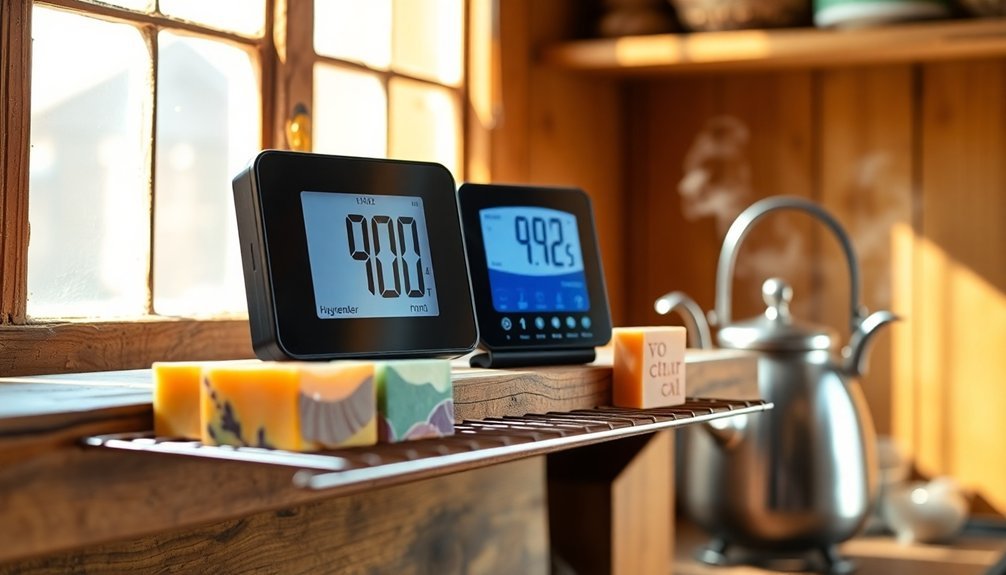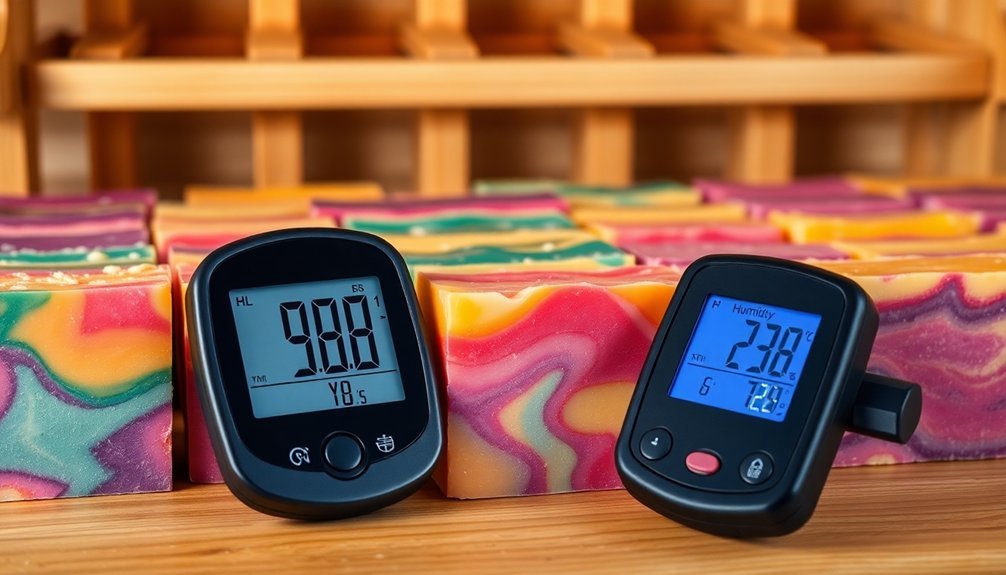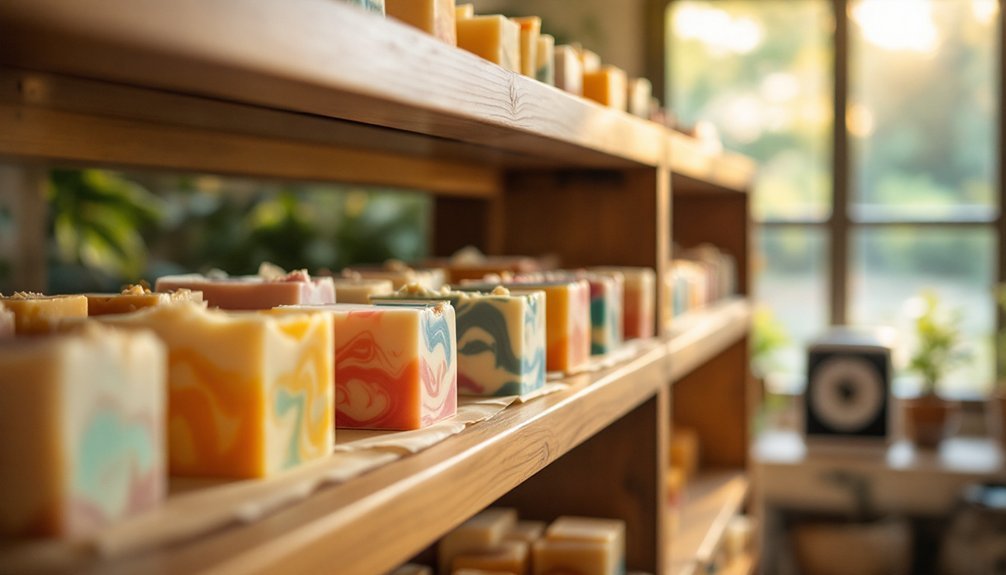You'll achieve consistent soap quality by monitoring curing conditions with these three smart tools: digital hygrometers to track humidity levels in real-time, precision scales to measure weight loss as moisture evaporates, and environmental data loggers to record temperature and air quality. Set up a simple tracking system with these affordable devices to establish baseline measurements and adjust curing times accordingly. These monitoring methods will transform your soap making from guesswork to science.
Digital Hygrometers: The Key to Precision Humidity Control

When it comes to perfecting your soap curing process, digital hygrometers serve as invaluable tools for maintaining precise humidity control.
These affordable devices provide real-time monitoring of both humidity and temperature, ensuring ideal curing conditions for your soap creations.
You'll appreciate their clear displays that show current environmental readings at a glance.
Most models, including the popular SugarVeil option at just $9, come with batteries included and require minimal maintenance.
Their compact size lets you place them anywhere in your curing area.
For best results, position your hygrometer centrally among your curing soaps.
You can pair it with a dehumidifier to further fine-tune conditions based on specific recipes.
Just as with measuring specific gravity for caustic soda solutions in soap making, precision is key to successful outcomes.
This precise monitoring helps reduce waste from improperly cured soaps while potentially speeding up the entire process.
Weight Tracking Systems for Monitoring Water Loss
As soap cures, tracking its weight loss provides critical insights into the drying process and helps predict when your bars will reach their ideal state. You'll need a precision digital scale that can measure small changes accurately. Weigh your soap immediately after unmolding to establish your baseline. This process monitors the evaporation of excess liquid that directly contributes to the finished soap's mildness and moisturizing properties.
| Time Period | Expected Loss | Action | Documentation |
|---|---|---|---|
| First week | 5-8% | Weigh every 2 days | Record in spreadsheet |
| Weeks 2-3 | 3-5% | Weigh weekly | Calculate % loss |
| Weeks 4-6 | 1-2% | Weigh biweekly | Note environmental conditions |
| Final stage | <1% | Final weight check | Determine net weight for labels |
Remember that environmental factors like humidity and temperature will affect your soap's weight loss rate. Consistent tracking helps you adjust curing times and guarantees accurate product labeling.
Environmental Data Logging for Optimal Curing Conditions

Consistent monitoring of your soap's curing environment can greatly improve product quality and reduce batch variations. Invest in automated sensors that track temperature (ideally 65°F-75°F), humidity, and air quality while storing data on cloud platforms for remote access.
Set up real-time alerts for environmental fluctuations to maintain favorable conditions throughout the curing timeframe, which may extend from weeks to months depending on your recipe. Regular sensor calibration guarantees your readings remain accurate over time.
Consider integrating IoT devices and machine learning algorithms to predict ideal curing conditions based on historical performance. This technology not only improves product consistency but also enhances sustainability by maximizing energy usage and reducing waste from improperly cured batches. Implementing circular economy principles during your production process can significantly reduce the ecological footprint of soap manufacturing.
Proper air circulation is essential to prevent mold while supporting even curing.
Frequently Asked Questions
Can Curing Be Accelerated Using Dehumidifiers Without Compromising Quality?
Yes, you'll find dehumidifiers effectively accelerate soap curing by removing excess moisture without compromising quality. They're especially useful in humid climates, reducing curing time to about three weeks while maintaining hardness and mildness.
How Do Seasonal Changes Affect Soap Curing Timelines?
Seasonal changes greatly impact your soap curing timeline. You'll notice faster curing in warm, dry seasons and slower progress during humid, cold periods. Adjust your expectations and storage conditions accordingly for ideal results.
What Ph Changes Indicate Properly Cured Soap?
Your soap is properly cured when its pH drops from 10-12 to 8-10 range. You'll notice this change after 4-6 weeks, indicating the lye has fully reacted and your soap is safe for skin use.
Do Different Essential Oils Affect Curing Time Requirements?
No, essential oils don't greatly affect your soap's curing time. The curing period is primarily determined by your base oil recipe, water content, and environmental conditions like humidity and temperature—not the essential oils you've added.
How Do You Determine When Soap Is Fully Cured Without Equipment?
You'll know your soap is fully cured when it feels hard and dry to the touch, produces a rich lather, has a vibrant color, and weighs noticeably less than when you first made it.
In Summary
You've now got three powerful tools to transform your soap curing process. With digital hygrometers, weight tracking systems, and environmental data logging, you'll gain unprecedented control over humidity, water loss, and curing conditions. You're no longer guessing—you're making informed decisions based on real data. These smart monitoring approaches won't just improve your soap quality; they'll revolutionize your entire production process.





Leave a Reply